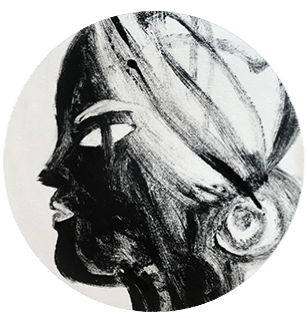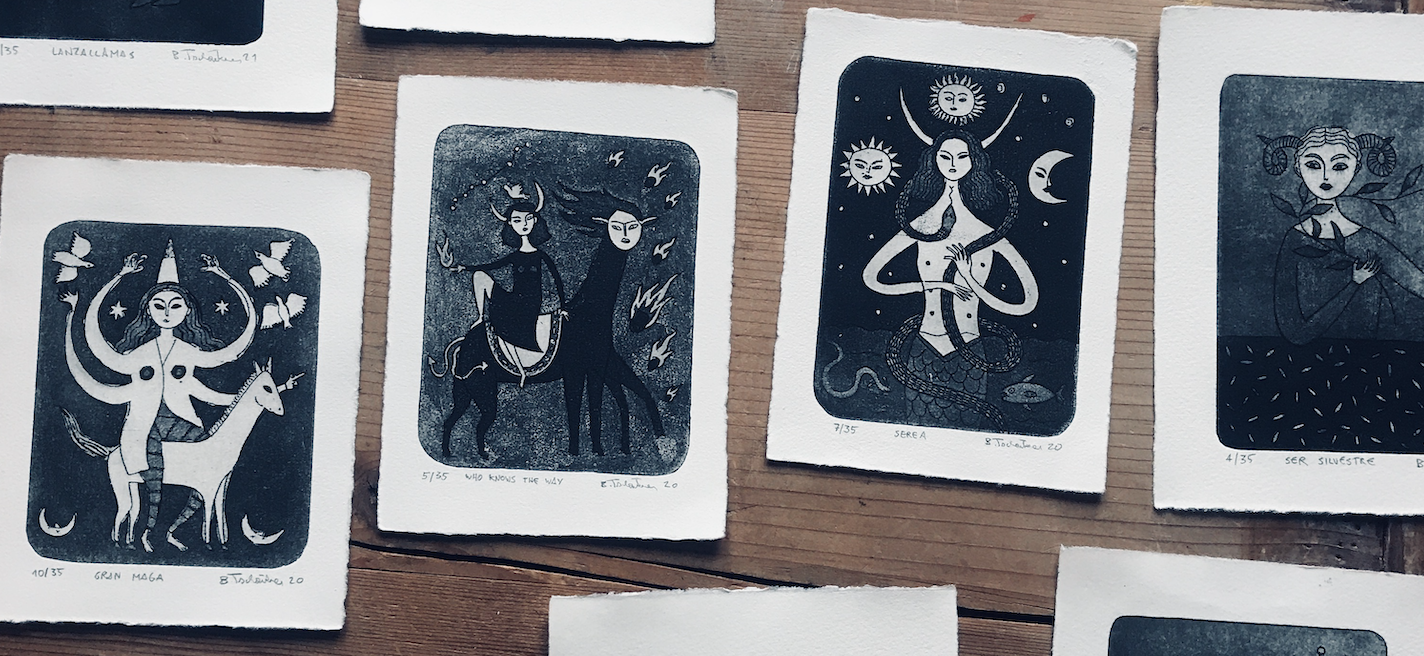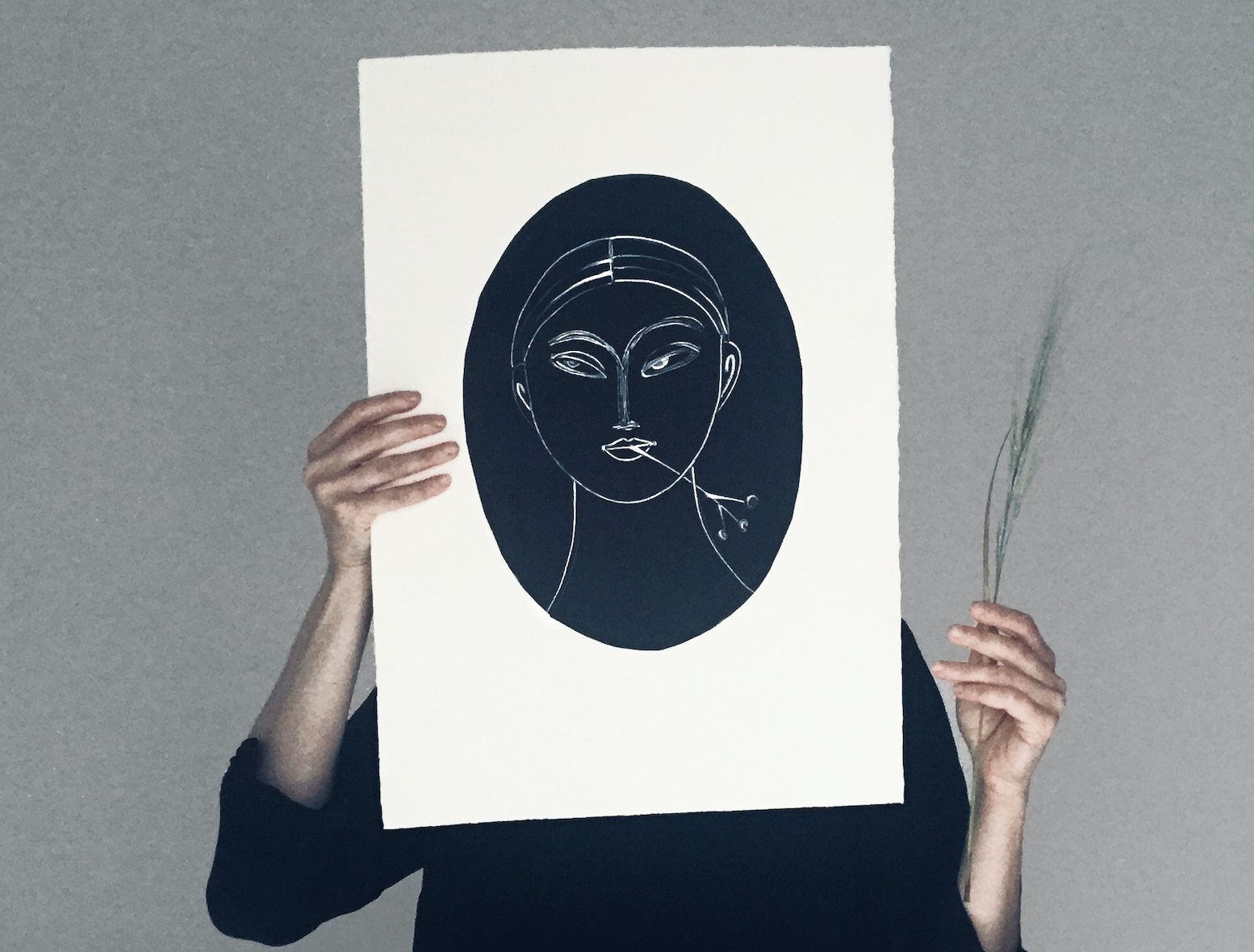Nature is not only all that is visible to the eye. It also includes the inner pictures of the soul.
Edvard Munch
This artwork, called Leira (which means field in Galego) is a monotype print with a face that appeared to me one day while painting in Betanzos, a small village in Galicia, a remote province in Northern Spain. I'm not a studio artist; I need inspiration, and I like and need to create my artworks in the context of different surroundings. Galicia is one of my favorite places to hunt for these inner images. Actually, one doesn't need to hunt for them, really one shouldn’t; they just appear, the less one tries to "seek inspiration", the more probable it is that one finds it. Inspiration has nothing to do with thinking, and everything to do with feeling.
Inspiration doesn't like force, and whatever inspiration is, it is certainly a free spirit, and a stubborn one. It comes when it wants to, not when you want. Inspiration comes to me when I walk, when I work, and most of all, when I let go.
I no longer wait to have “an idea” and I certainly don’t think they are “mine”. Ideas are floating around us all the time, like invisible butterflies, you can’t catch them, but if you’re lucky, one of them sits on your shoulder.
In Galicia, you find inspiration between the trees in the forest, or behind that beautiful green hill, or in the image of a ship on the horizon, or in one of the old fisherman’s bars. I just walk, I don't think and I don't search, I let my soul soak in that beautiful (and sometimes not so beautiful) world around me.
And then I go back to the studio, take my brush, and images will appear. But because they want to.
Through the years, I’ve learned how to play with the muse, although it was, and is, not always that easy, as this poem reminds me of:
Two weeks
In the first week, you meet your demons.
They pull on your pencil when you draw, and fill your mind with lead.
They step in your way in the middle of the forest.
They push your muse and make her stumble –
and out of the mirror, they make faces at you.
Your demons make sure you know that they don’t love you
(but then again, they don’t love anyone).
And you know it’s best just to let them be
– like the ants, the mosquitoes, and that gigantic cricket in your ear.
Eventually, they will get bored and leave.
Then, one day, arrives an angel.
She opens your shutters and makes your day soft.
She breathes life into the world, and you breathe out.
She hands you your papers (the ones with the demon sketches)
and leaves (her visits are always short)
And she leaves you feeling blessed and tall.
The next day, the muse returns from the hills.
Her pale face has gained some color – her cheeks are rosy and busy.
She sits down with you at the table and says: Let’s start!
You look at her, astonished but determined,
and you know that half of your time is already over.
And you bow your head and begin the work.
And the day is endless and you fill it out effortlessly.
I wrote this in my notebook two years ago in another country, in another village, in Castagno de Piteccio, a little mountain village in Tuscany. I had been invited there to participate in a two-week-long artist residency, and it happened to me what had happened to me many times before and what I guess most artists are experiencing in some or the other way: I had two weeks to develop a project, and I immediately I got into the vicious circle of pressurizing myself and ending up in total despair, just before, miraculously, everything all of a sudden started to flow. In this case, it started to flow with this poem.
The muse wants to be seduced, not to be forced. Start to draw, line by line, and it will be one line, you don’t know which, that will be so irresistible for the muse (her other name is association) that she will jump on it and guide you the way. “The muse will come, but it will have to find you working”, says Picasso.
There is no magic way to be more “efficient”, more “productive”, “faster”. The muse refuses these things. Because the absence of these things is not the problem, the problem is that we see it as a problem.
The artistic process is not linear. It is cyclical, and there is a time to sow, to grow, and to harvest. Good things need time. It is better to accept this and give oneself the time one needs, to surrender, to let go. Going with the flow also means accepting that the flow sometimes comes to a halt for a little while. It is up to us whether the time we spend inviting the muse is a punishment or a gift. If you have time (and patience, of course), it can be a wonderful gift. Searching for the muse with open eyes and an open heart becomes a creative act in itself – it is one of the most beautiful ways of interacting with the world. The muse playing hide and seek with you is a punishment only in the framework of obligations and expectations – the muse wanders around in far forests, or above the clouds, god knows where, while we desperately wait for her in the city, in our studios, in universities, sitting at our desks. This is reality.
Unlike us, the ancient Greeks did not cherish the illusion that our ideas are something that is coming from inside ourselves. For them, ideas and inspiration come from the genius, which is an entity existing outside ourselves, originally a guardian spirit, and which is etymologically linked to “giving birth”. Every human being has their own “genius”, and all ideas we have are given to us by them. And so I like to see creativity not as an act, something I execute by myself, alone, but an interaction, a collaboration. Abandoning the idea that it is all in our control, which has always been an illusion in the first place, and embracing the fact that everything in this world is a collaboration, and that there is a genius, a muse, an angel, however you want to call it, somewhere out there, coming for help eventually, makes things a lot easier. We lend a face to the faceless, and a creative block in the shape of a mischievous demon who has come to make faces at us, and who we know will eventually leave, is a little bit easier to bear.
Since I wrote this poem, I’ve become a lot better at dealing with my demons and trusting my angel and my muse*. I have learned to arrange myself with my demons, not only laughing at them but also laughing with them. If they want me to draw nonsense for three days before getting any result, I’ll give it to them. I’ll have to, anyway.
I have also learned that, no matter where I am, my angel is always with me, and I’ve learned to let my muse get out of sight, let her lost in the dark forest, and trust her always to come back to me.
____________________________
*If you have read Gabriel Garcia Llorcas Theory and play of the duende, you will have noticed that my triangle of angel, muse and demon, alludes to the triangle he describes in his text, except that I have replaced Llorca’s Duende with the demon, which of course is an entirely different thing than the Duende of course – its opposite, actually.



